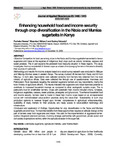| dc.description.abstract | Objective: Competition for land use among crops in the Nzoia and Mumias sugar belts hastened to favour sugarcane and maize at the expense of indigenous food crops such as onions, tomatoes, cassava and sweet potatoes.This in part explains the persistent food insecurity situation in these regions. This stud investigated the income potential of diverse crops as a basis of encouraging farmers in the area to diversify their sources of livelihoods.Methodology and results: An income analysis based on a social survey research was conducted in Webuye and Matungu-Mumias areas in western Kenya. The survey involved45 farmers from Nzoia and 43 fromMatungu. In both sites respondents were selected randomly from farmers lists obtained from the local ministry of agriculture offices.Data were collected the through use of questionnaires, interviews and Participatory Rural Appraisals targeting the selected sugarcane farmers and key respondents, mainly the local ministry of agriculture officers.The results indicated that sugarcane and maize have less potential to contribute to increased household incomes as compared to other ecologically suitable crops. This is particularly true for smallholder farmers. Crops with potentially high income included onions, tomatoes,indigenous vegetables, cassava, sweet potatoes, pineapples and groundnuts. To enhance household food and income security, farmers need to investing these highincome crops based on an entrepreneurial institutionalized value-addition practices along the value-chain. Sustainability of such crop production systems is however hinged upon farmers’ competences in agricultural entrepreneurship,availability of ready markets for their products, and ready access to value-addition technology and infrastructure.Conclusion and application of findings:Opportunities for crop diversification in the Nzoia and Mumias sugar belts are enormous. To maximize benefits from these opportunities requires an attitude change on the part of farmers away from sugarcane and maize.This calls for the implementation of aggressive farmer-centered integrated extension services, involving strategic intergovernmental, private sector and civil society organizations working within the agricultural sector in the sugar belt. | en_US |

